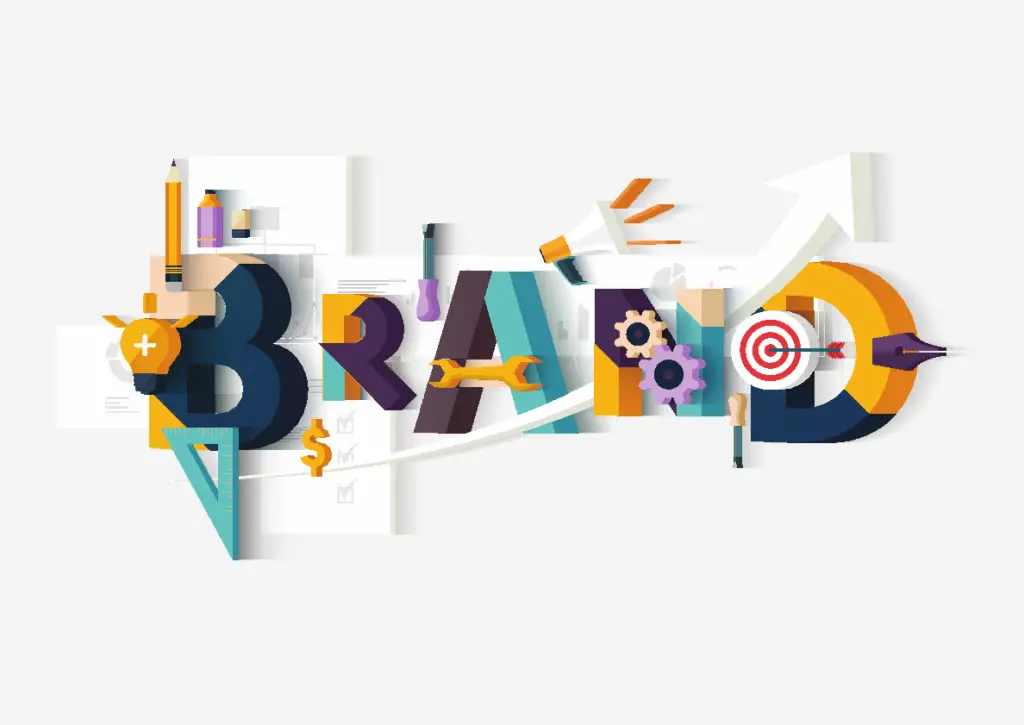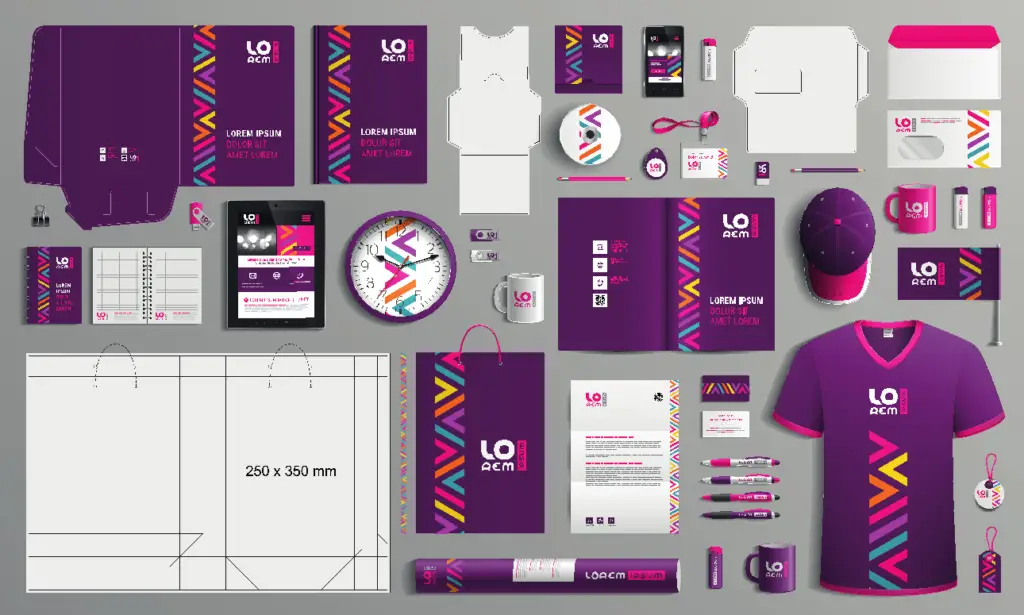A brand, visual branding, and a logo are related but not the same. New businesses need to understand the differences between them and how they work together if they want to get the most from their marketing.

Table of Content
What is a Brand?
The definition of a brand is so simple that many businesses feel the need to overcomplicate it. To be blunt: A brand is nothing more than how something is represented to the public. That “something” may be a specific product, a product line, an entire company, or even a person.
This image, or brand, is controllable to an extent. Every interaction with the public has the power to reshape the brand. It doesn’t matter whether it is conversing with customers on social media or how and where the brand chooses to advertise.
Therefore, protecting and promoting a brand is crucial. A well-known and well-liked brand can make marketing easy, while an unpopular or unknown brand can make it extremely difficult to turn people into customers.
While both visual branding and a company logo can contribute to creating and cultivating a brand, it is possible to have a brand without either. However, it’s impossible to create meaningful visual branding or the perfect logo without first nailing down the key elements of a brand.
Key Elements of a Brand
Brand value
All brands must portray good value. Some people refer to this value offered to customers as a unique selling proposition. So, what is yours? What should customers expect from you, and what are you promising to deliver?
Customers persona
When it comes to marketing, never do anything without having a clear picture of the ideal buyer. Maybe your customers are value-focused, or possibly they prefer quality regardless of the cost? Are you happy with your current customer base? If not, how can you make adjustments to your brand to reach different people?
Personality
Each brand has a personality or set of characteristics it displays when interacting with the public. This personality directly affects a brand’s messaging. When deciding on a brand’s personality, remember that it must mesh with both who the brand wants to appeal to and its unique selling proposition.
What is Visual Branding?
Visual branding is how a brand uses colors, shapes, typography, fonts, symbols, and images to represent its values and personality. Some people prefer using “brand’s visual identity” instead of visual branding because it reflects the real purpose better. A great visual identity needs to be as instantly recognizable as a celebrity’s face.
Visual branding influences every design associated with the brand. Nowhere is it more critical than when creating a logo. But before jumping ahead to planning a new logo, businesses need to create a mature visual identity that fully represents a brand. When thinking about your visual branding, keep the following critical aspects in mind.
Key Elements of Visual Branding
- Easily recognizable from other brands
- Understand an unknown brand
- Attractive across a variety of mediums
Easily recognizable from other brands
The primary purpose of visual branding is to allow someone to immediately distinguish a known brand with just the smallest of visual clues.
For example, you will never mistake the bold, blocky capital lettering and green and white of Starbucks for the cursive lettering and red and white color palette of Coca-Cola. What makes your visual brand unique?
Understand an unknown brand
Making it easy for someone to identify a known brand is just one objective of visual branding. Outstanding visual branding should be able to subliminally suggest a brand’s core principles to someone who is experiencing the brand for the first time. Think of the visual clues that greet a customer when he steps into an IKEA store.
The blue and yellow color palette and the use of umlauts in the product names instantly suggest a Swedish origin. At the same time, the blocky, oversized font indicates the company’s products are no-nonsense and sturdy.
Attractive across a variety of mediums
To get the most from your visual branding, you have to use it consistently across a range of mediums. It better look as good on a T-shirt or shopping bag as it does on a billboard or print ad. Keeping things simple and uncluttered is often the best way to ensure visual branding is useable in as many situations as possible.

What is a Logo?
A logo is a graphical or text-based representation of a brand. A good logo needs to distill the entire essence of a brand into a single visual expression that is easily recognizable and attractive.
Since logos need to reflect the foundations of a brand and adhere to existing visual branding, it has to be the last aspect of building out a brand’s image. But in many ways, it is most important. Take your time with logo creation and try to incorporate the following vital elements.
Key Elements of a Logo
Simple is better
When choosing a logo, keep things as simple as possible. Although logos may contain any of the aspects used to create the brand’s visual identity, they probably should not include them all. For example, could the Mercedes-Benz logo be any simpler, yet somehow it still perfectly reflects the company.
Color conscience
The need for simplicity extends to color. While the logo colors need to reflect the visual branding, if the color palette is extensive, choosing a maximum of three is best. A single color offers maximum versatility, but it may require more than one color to invoke the desired messaging. Timeless and universal.
Logos are meant to last
That means avoiding using anything that may eventually seem old or out-of-date. As logos need to have widespread appeal, steer clear of symbols or images that may be either unrecognizable to some people or have alternative meanings based on cultural differences.
Several of the most popular types of logos include:
- Image-based logos: These kinds of logos use only an easily recognizable or abstract image. Imaged-based logos work across language barriers, but without the addition of any text, consumers may be able to recognize the logo but not know the brand’s name.
- Word-based logos: These logos apply typography and a specific font to the brand’s name to help deliver a core message visually. Stylized word-based logos are versatile, and the consumer knows the name of the brand, though the meaning behind the brand isn’t as overt.
- Combination logos: These logos combine both images and text into one logo. Combination logo offers the advantages of the other two varieties, with the only downside being a slight loss of versatility.
With so much riding on your brand, visual branding, and logo, you can’t afford to make a mistake. Get the help you need now to ensure the launch of your new business is successful.
Marketing Management
(Click on Topic to Read)
- What Is Market Segmentation?
- What Is Marketing Mix?
- Marketing Concept
- Marketing Management Process
- What Is Marketing Environment?
- What Is Consumer Behaviour?
- Business Buyer Behaviour
- Demand Forecasting
- 7 Stages Of New Product Development
- Methods Of Pricing
- What Is Public Relations?
- What Is Marketing Management?
- What Is Sales Promotion?
- Types Of Sales Promotion
- Techniques Of Sales Promotion
- What Is Personal Selling?
- What Is Advertising?
- Market Entry Strategy
- What Is Marketing Planning?
- Segmentation Targeting And Positioning
- Brand Building Process
- Kotler Five Product Level Model
- Classification Of Products
- Types Of Logistics
- What Is Consumer Research?
- What Is DAGMAR?
- Consumer Behaviour Models
- What Is Green Marketing?
- What Is Electronic Commerce?
- Agricultural Cooperative Marketing
- What Is Marketing Control?
- What Is Marketing Communication?
- What Is Pricing?
- Models Of Communication
Sales Management
- What is Sales Management?
- Objectives of Sales Management
- Responsibilities and Skills of Sales Manager
- Theories of Personal Selling
- What is Sales Forecasting?
- Methods of Sales Forecasting
- Purpose of Sales Budgeting
- Methods of Sales Budgeting
- Types of Sales Budgeting
- Sales Budgeting Process
- What is Sales Quotas?
- What is Selling by Objectives (SBO)?
- What is Sales Organisation?
- Types of Sales Force Structure
- Recruiting and Selecting Sales Personnel
- Training and Development of Salesforce
- Compensating the Sales Force
- Time and Territory Management
- What Is Logistics?
- What Is Logistics System?
- Technologies in Logistics
- What Is Distribution Management?
- What Is Marketing Intermediaries?
- Conventional Distribution System
- Functions of Distribution Channels
- What is Channel Design?
- Types of Wholesalers and Retailers
- What is Vertical Marketing Systems?
Marketing Essentials
- What is Marketing?
- What is A BCG Matrix?
- 5 M'S Of Advertising
- What is Direct Marketing?
- Marketing Mix For Services
- What Market Intelligence System?
- What is Trade Union?
- What Is International Marketing?
- World Trade Organization (WTO)
- What is International Marketing Research?
- What is Exporting?
- What is Licensing?
- What is Franchising?
- What is Joint Venture?
- What is Turnkey Projects?
- What is Management Contracts?
- What is Foreign Direct Investment?
- Factors That Influence Entry Mode Choice In Foreign Markets
- What is Price Escalations?
- What is Transfer Pricing?
- Integrated Marketing Communication (IMC)
- What is Promotion Mix?
- Factors Affecting Promotion Mix
- Functions & Role Of Advertising
- What is Database Marketing?
- What is Advertising Budget?
- What is Advertising Agency?
- What is Market Intelligence?
- What is Industrial Marketing?
- What is Customer Value
Consumer Behaviour
- What is Consumer Behaviour?
- What Is Personality?
- What Is Perception?
- What Is Learning?
- What Is Attitude?
- What Is Motivation?
- Segmentation Targeting And Positioning
- What Is Consumer Research?
- Consumer Imagery
- Consumer Attitude Formation
- What Is Culture?
- Consumer Decision Making Process
- Consumer Behaviour Models
- Applications of Consumer Behaviour in Marketing
- Motivational Research
- Theoretical Approaches to Study of Consumer Behaviour
- Consumer Involvement
- Consumer Lifestyle
- Theories of Personality
- Outlet Selection
- Organizational Buying Behaviour
- Reference Groups
- Consumer Protection Act, 1986
- Diffusion of Innovation
- Opinion Leaders
Business Communication
- What is Business Communication?
- What is Communication?
- Types of Communication
- 7 C of Communication
- Barriers To Business Communication
- Oral Communication
- Types Of Non Verbal Communication
- What is Written Communication?
- What are Soft Skills?
- Interpersonal vs Intrapersonal communication
- Barriers to Communication
- Importance of Communication Skills
- Listening in Communication
- Causes of Miscommunication
- What is Johari Window?
- What is Presentation?
- Communication Styles
- Channels of Communication
- Hofstede’s Dimensions of Cultural Differences and Benett’s Stages of Intercultural Sensitivity
- Organisational Communication
- Horizontal Communication
- Grapevine Communication
- Downward Communication
- Verbal Communication Skills
- Upward Communication
- Flow of Communication
- What is Emotional Intelligence?
- What is Public Speaking?
- Upward vs Downward Communication
- Internal vs External Communication
- What is Group Discussion?
- What is Interview?
- What is Negotiation?
- What is Digital Communication?
- What is Letter Writing?
- Resume and Covering Letter
- What is Report Writing?
- What is Business Meeting?
- What is Public Relations?
Business Law
- What is Business Law?
- Indian Contract Act 1872
- Essential Elements of a Valid Contract
- Types of Contract
- What is Discharge of Contract?
- Performance of Contract
- Sales of Goods Act 1930
- Goods & Price: Contract of Sale
- Conditions and Warranties
- Doctrine of Caveat Emptor
- Transfer of Property
- Rights of Unpaid Seller
- Negotiable Instruments Act 1881
- Types of Negotiable Instruments
- Types of Endorsement
- What is Promissory Note?
- What is Cheque?
- What is Crossing of Cheque?
- What is Bill of Exchange?
- What is Offer?
- Limited Liability Partnership Act 2008
- Memorandum of Association
- Articles of Association
- What is Director?
- Trade Unions Act, 1926
- Industrial Disputes Act 1947
- Employee State Insurance Act 1948
- Payment of Wages Act 1936
- Payment of Bonus Act 1965
- Labour Law in India
Brand Management







